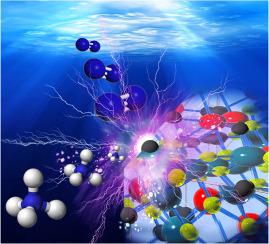Applied Catalysis B: Environment and Energy ( IF 22.1 ) Pub Date : 2021-08-30 , DOI: 10.1016/j.apcatb.2021.120680 Yi Zhang 1 , Jun Di 2 , Xu Qian 3 , Mengxia Ji 1 , Ziqi Tian 3 , Liqun Ye 4 , Junze Zhao 1 , Sheng Yin 1 , Huaming Li 1 , Jiexiang Xia 1

|
Constructing highly efficient ultra-small nanomaterials to achieve nitrogen reduction without sacrificing reagents or additional photosensitizers is still challenging. Herein, one-step solvothermal method was used to tune Bi2Sn2O7 to the quantum dots (QDs), so as to tune the active sites on the surface and achieve the optimization of the energy band structure. Benefiting from quantum size effect and electron back-donation mechanism of surface oxygen vacancies, the improved charge migration and optimized molecular nitrogen activation in Bi2Sn2O7 QDs can be achieved, triggering excellent photocatalytic nitrogen fixation behavior. The ammonia generation rate over Bi2Sn2O7 QDs is up to 334.8 µmol g−1 h−1 in pure water, 12.2 times higher than the bulk counterpart. The density functional theory revealed that the rate-limiting step energy barrier during the nitrogen fixation reaction can be lowered by oxygen vacancy engineering. This work would provide new insights into the synthesis of defect-state quantum dots and nitrogen photoreduction reactions.
中文翻译:

Bi2Sn2O7量子点中的氧空位触发有效的光催化氮还原
构建高效的超小型纳米材料以在不牺牲试剂或额外光敏剂的情况下实现氮还原仍然具有挑战性。在此,采用一步溶剂热法将Bi 2 Sn 2 O 7调谐到量子点(QD)上,从而调整表面活性位点,实现能带结构的优化。受益于表面氧空位的量子尺寸效应和电子回馈机制,可以实现Bi 2 Sn 2 O 7量子点中改进的电荷迁移和优化的分子氮活化,触发优异的光催化固氮行为。Bi 2 上的氨生成率纯水中的Sn 2 O 7 QDs 高达 334.8 µmol g -1 h -1,是本体的 12.2 倍。密度泛函理论表明,固氮反应过程中的限速步能垒可以通过氧空位工程降低。这项工作将为缺陷态量子点的合成和氮光还原反应提供新的见解。


























 京公网安备 11010802027423号
京公网安备 11010802027423号